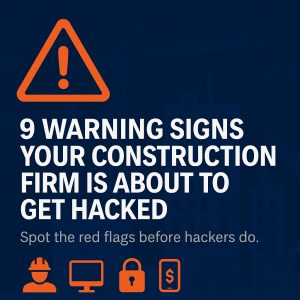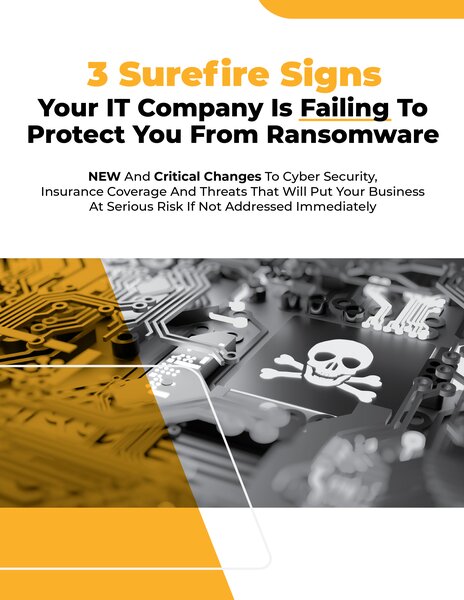 Let’s be honest — you’ll probably never know when your company is about to be hacked. But if you’re not paying attention, the warning signs are already there.
Let’s be honest — you’ll probably never know when your company is about to be hacked. But if you’re not paying attention, the warning signs are already there.
Last year, over 75% of small business cyber incidents involved ransomware. Hackers don’t need to target the big guys anymore — they just need one distracted employee, one old laptop, or one unsecured device on a jobsite.
And for your IT Director, that means stress and sleepless nights. For their boss, the CFO, it means downtime, lost productivity, and unexpected costs that hit hard.
Here are nine warning signs your construction firm could be next — and what you can do about it.
1. You’re Losing Employees Faster Than Usual
When turnover is high, data often walks out the door. Sometimes it’s accidental — a thumb drive or personal Dropbox folder. Other times, it’s intentional.
Fix it: Exit checklists should include data access. Remove logins immediately and make sure departing employees can’t take client or project data with them.
2. Your Team Works Remotely or on the Move
Field tablets, trailer Wi-Fi, mobile apps — your team is constantly on the go. Every new connection point is a potential entry point for hackers.
Fix it: Use secure VPNs, enforce MFA, and make sure all jobsite devices connect through monitored, encrypted networks.
3. You Don’t Have Dedicated IT Support
If you’re still “calling a guy” when something breaks, you’re at risk. Hackers don’t wait for office hours.
Fix it: Whether it’s an internal IT lead or an outsourced MSP, you need 24/7 monitoring and regular security audits. Think of it like preventative maintenance — for your data instead of your equipment.
4. You’re Skipping Security Software
Hackers automate attacks. Your defenses should be automated too. If every device isn’t running active, updated antivirus and endpoint protection, you’re wide open.
Fix it: Tools like Bitdefender or Malwarebytes run quietly in the background and block threats before they spread across your network.
5. Your Employees Haven’t Been Trained
It only takes one wrong click. Most breaches start with someone opening a bad link or attachment.
Fix it: Train your team quarterly. Run phishing simulations. Reward employees who report suspicious emails. Security training shouldn’t be optional — it’s part of doing business.
6. You Don’t Have Data Security Procedures
If you’re handling bids, blueprints, or client contracts and don’t have policies around how that data is stored or shared, it’s only a matter of time before something leaks.
Fix it: Develop written data-handling procedures. Encrypt sensitive files. Limit access to what employees actually need.
7. Your Equipment Is Outdated
Still running Windows 10 or an old server? That’s like leaving your jobsite gate unlocked. Hackers look for outdated systems because they know exactly how to break in.
Fix it: Keep all software current and upgrade devices that can’t run supported systems. The cost of a new PC is nothing compared to a ransomware bill.
8. You Don’t Have a BYOD Policy
When employees use personal phones or laptops for work, you lose visibility. One infected phone can compromise your entire network.
Fix it: Create a clear “Bring Your Own Device” policy. Either issue company-managed devices or use mobile device management (MDM) software to secure personal ones.
9. You Don’t Enforce Strong Passwords
If your team can still use “1234” as a password, you’re basically holding the door open.
Fix it: Require complex passwords and rotate them regularly. Even better — use a password manager and multifactor authentication (MFA) everywhere.
The Bottom Line
No, you can’t eliminate risk entirely. But if any of these nine red flags sound familiar, hackers already see your firm as an easy target.
The good news? Every one of these problems can be fixed — fast.
Schedule a free discovery call with our team today. We’ll walk you through a quick security assessment and help you lock things down before it’s too late.
Because in construction, your projects depend on trust — and trust depends on keeping your data safe.
—
Preston Borchelt, President/CEO
Turning tech talk into real-world relief for construction leaders



